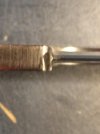So I put my Grayman Dua on my edge pro last night. It was the first time I'd sharpened it so I wanted to regrind the levels to a more usable angle. I set the sharpening rod at 22 degrees and got to work with the factory 120 grit stone. The factory was pretty uneven and took me awhile to raise a consistent burr but when I flipped the blade over to work on the other side, no matter how hard I tried I couldn't get the bevels to match width. What am I doing wrong? I held the blade in the same position relative to the sharpening table on both sides and never changed angles so why is one side bevel wider than the other?


Not the best pictures but you can clearly tell one bevel is wider than the other. All advice is welcome. Thanks for your help


Not the best pictures but you can clearly tell one bevel is wider than the other. All advice is welcome. Thanks for your help




